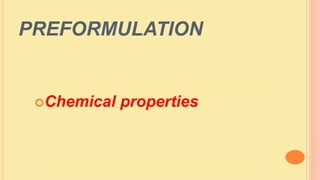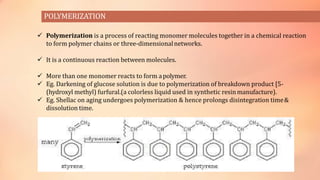Preformulation (chemical properties)
- 2. CHEMICAL PROPERTIES /PROCESSES: ’üČ Oxidation and Reduction ’üČ Hydrolysis. ’üČ Racemization. ’üČ Polymerization.
- 3. CHEMICAL CHARACTERISTICS: Oxidation: It is very common pathway for drug degradation in both liquid and solid formulation. ’āś Oxidation is the gain of oxygen, loss of hydrogen and/or loss of electrons When iron reacts with oxygen it forms a chemical called rust. The iron is oxidized andthe oxygen is reduced. ’ü▒ Oxidation occurs in two ways ’āś Auto oxidation ’āś Free radical oxidation
- 4. Commonly viewed example of oxidation in daily life
- 5. FACTORS AFFECTING OXIDATION PROCESS 1) Oxygen concentration 2) Light 3) Heavy metals particularly those having two or more valencestate 4) Hydrogen & HydroxylIon 5) Temperature PREVENTION OF OXIDATION 1) Reducing oxygen content 2) Storage in a dark and cool condition 3) Addition of chelating agent (Eg. EDTA, Citric acid, Tartaric acid) 4) Adjustment of pH 5) Changing solvent (Eg. Aldehydes, ethers, Ketones, may influence free radical reaction) 6) Addition of an antioxidant or reducing agent (e.g. H2, CO, Zn etc.).
- 6. HYDROLYSIS o It is the cleavage of chemical bonds by the addition of water. o The reaction of water with another chemical compound to form two or more products,involving ionization of the water molecule usually splitting the othercompound. Examples include : o the formation of acids or bases from dissolved ions. When this attack is by a solvent other than water than it is known assolvolysis
- 7. PREVENTION OF HYDROLYSIS: ’üČpH adjustment o Formulate the drug solution close to its pH of optimum sability. o Addition of water miscible solvent in formulation o Optimum buffer concentration ’üČAddition of surfactant o Nonionic, cationic, and anionic surfactant stabilizes the drug against base catalysis ’üČSalts and Esters Eg. Phosphate esters of clindamycine o The solubility of pharmaceuticals undergoing ester hydrolysis can be reduced by forming less soluble salts. o By use of complexing agent
- 8. RACEMIZATION ’āś Racemization is the process in which one enantiomer of a compound, such as an L-amino acid, converts to the other enantiomer. ’āś The compound then alternates between each form while the ratio between the (+) and (ŌĆō)groups approaches 1:1, at which point it becomes optically inactive. ’āś If the racemization results in a mixture where the enantiomers are present in equal quantities, the resulting sample is described as racemeric or a racemate.
- 9. ’āś The inter-conversion from one isomer to another can leadto o different pharmacokinetic properties (ADME) as wellas o different pharmacological & o toxicological effect. ’āś Example: L-epinephrine is 15 to 20 times more active than D-form, while activity of racemic mixture is just one half of theL-form. ’āś It depends on o temperature, o solvent, o catalyst & o presence or absence of light
- 10. Biological significance: ŌĆó Many psychotropic drugs show differing activity or efficacy between isomers, e.g. Amphetamine is often dispensed as racemic salts while the more active dextro- amphetamine is reserved for severe indications; ŌĆó Another example is Methadone, of which one isomer has activity as an opioid agonist and the other as an NMDA antagonist.
- 11. POLYMERIZATION ’ā╝ Polymerization is a process of reacting monomer molecules together in a chemical reaction to form polymer chains or three-dimensionalnetworks. ’ā╝ It is a continuous reaction between molecules. ’ā╝ More than one monomer reacts to form apolymer. ’ā╝ Eg. Darkening of glucose solution is due to polymerization of breakdown product [5- (hydroxyl methyl) furfural.(a colorless liquid used in synthetic resin manufacture). ’ā╝ Eg. Shellac on aging undergoes polymerization & hence prolongs disintegration time& dissolution time.











